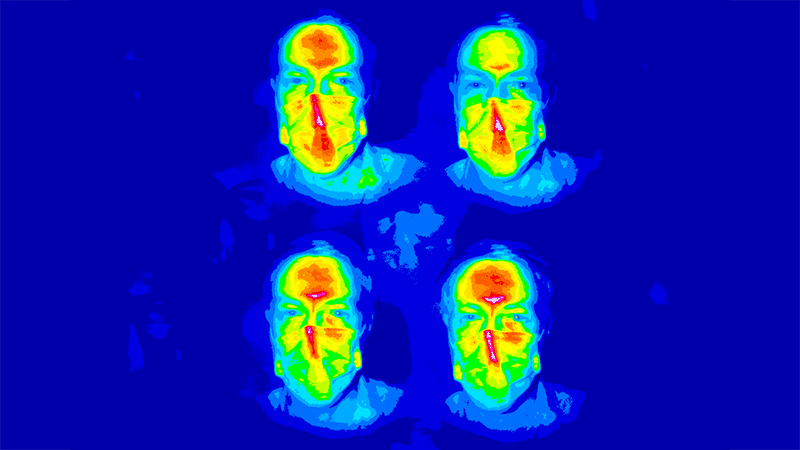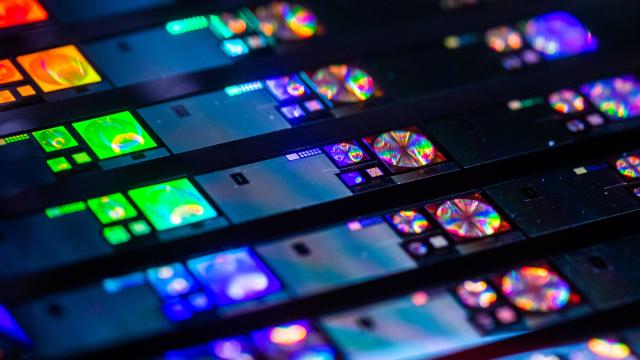As effortless as Apple’s Face ID is at allowing you to securely authenticate your identity, the feature comes with several drawbacks, not the least of which being a hideous notch at the top of your iPhone’s screen. Metalenz, a company spun out of Harvard University, believes it has a better approach to facial biometrics: a new lens technology that uses polarised light for improved security that can also be hidden beneath a smartphone’s screen.
Metalenz, as the company’s name implies, was founded on relatively new technology known as metalenses (and metasurfaces) that promises to revolutionise cameras and the approach to making lenses we’ve used for over 150 years. Most cameras, including the ones on the front and back of your smartphone, rely on a lens that’s actually made up of several stacked lens elements that are each strategically shaped and arranged to bend light and direct it towards a sensor with minimal distortions and aberrations introduced along the way. This approach produces very clean and sharp images, but at a cost: size. The more lens elements you use, the better the image a camera can capture, which is why the high-quality lenses used by professional photographers on DSLR cameras are gigantic (much larger than the cameras themselves) and why your excellent smartphone camera has added a considerable bump on the back of your device.
Manufacturing camera lenses is also an exacting process, requiring elements to be perfectly curved and polished to bend and redirect light as it passes through, which is why a good lens for your camera can cost thousands of dollars. Metalenses take an entirely different approach to the problem. Instead of a perfectly smooth and curved finish, metalenses are thin and completely flat with a surface covered in thousands of microscopic nanostructures laid out in patterns that look like a series of concentric circles. These nanostructures effectively do the same thing the curved surface of a traditional lens element does, bending and redirecting light, but just a single metalens is needed to produce results as good, if not better, than current lens technology allows.
The benefits of using metalenses are numerous. They can be manufactured en masse — millions of them every day — using the same equipment used to make microchips, which makes them much cheaper to implement in consumer devices like smartphones. A single lens also means more light is hitting a camera sensor, improving its ability to capture images in low light. But more importantly, metalenses promise to eliminate camera bumps on smartphones, and soon, that ugly notch at the top of your iPhone’s screen.
Today Metalenz announced a new version of its metalens technology called PolarEyes, which allows camera sensors to capture polarised light information that traditional camera systems typically ignore. Cameras that can capture polarised light aren’t a new idea, but they’re expensive and typically used in research, engineering, or medical fields for things like visually detecting skin cancer, spotting air pollution, and even studying the stresses on an object to preemptively detect areas that might fail or break. Metalenz believes the technology can finally benefit consumers, too, because its approach makes the technology cheap enough to stuff in a smartphone.

Many smartphones’ facial recognition features can be easily fooled by high-quality masks or even printed headshots. But the polarised light bouncing off the skin of a human face looks distinctly different from the polarised light bouncing off a silicone mask or a printout, and the differences are easy to spot without complicated image-recognition algorithms or dedicated processors.
Apple’s Face ID is much harder to fool than many other facial recognition systems due to the iPhone’s TrueDepth camera, which projects invisible dots on a user’s face to capture and authenticate its 3D structure. But the projected grid pattern has a limited resolution, and in recent years we’ve all discovered that when a mask is covering half your face, Face ID is rendered unusable, requiring workarounds that compromise security.
Not only would Metalenz PolarEyes potentially help make security features like Face ID more secure, it would still work when only half a user’s face can be detected (i.e. when they are responsibly masked). On top of that, the iPhone’s TrueDepth camera could be replaced with a single sensor and a tiny metalens small enough to be hidden beneath a smartphone’s screen. It would eliminate the need for unsightly notches, and potentially even allow features like Face ID to finally be added to laptops (currently, screens are simply too thin to accommodate the hardware).
Metalens technology has a lot of potential, and while it’s great to see it moving past the research stages and out of the labs of universities like Harvard, there’s still no definitive timeline on when your next smartphone will lose its camera bump or notch. The timeline for when Metalenz’ technology will start showing up in consumer devices remains fuzzy, especially during a pandemic when supply chains have been thrown into chaos, but there is hope that one day your smartphone will completely replace the need for an expensive standalone digital camera — without a notched screen staring you in the face every time you pick it up.
